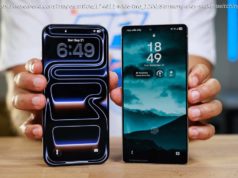The 2018 MacBook Air takes a multi-generational leap ahead in core processing, slimness, keyboard, connectivity, and storage speed. In other words, just about everything. Check out our first impressions.
Talk about a big-time pixel push. The IPS screen in the new MacBook Air, branded with Apple’s “Retina display” moniker, is a robust 2,560 by 1,600 pixels, topping out at a little more than 4 million pixels versus the mere 1.2 million of the previous model.
Indeed, with the reduced bezels around a same-size 13.3-inch screen, the MacBook Air is now 11.97 inches by 8.36 inches in footprint, shaving off more than a half-inch in both directions.
It also manages to lose a quarter-pound in the process. Handling the new Air, it now feels more like a current-gen laptop made of cutting-edge materials. (The fact that the frame is made of 100 percent recycled/reclaimed aluminum gives a bit of warm-fuzzy as well.) The earlier Airs, in their time, set the design standard for a sleek ultraportable. But by the time the 2017 MacBook Air emerged, it was feeling a bit portly for that category. On the slimdown trend, some Windows machines had lapped it. This model helps the Air catch up.
The Core (big and small “C”) processing: Here’s where the 2018 Air takes a big step forward, generationally speaking, though we’ll have to see how much the new silicon translates to real-world performance advances. Apple would not verify the exact chip model in the 2018 Air down to the nitty-gritty, but my suspicion (based on conversations with several reps who would not afford me Terminal access) is a slightly custom 8th-Generation Core Y-series CPU.
Apple calls it, evasively as ever, a “1.6GHz dual-core Intel Core i5, Turbo Boost up to 3.6GHz, with 4MB L3 cache.” This doesn’t correspond exactly to any of the “Kaby Lake Refresh” or “Whiskey Lake” Intel U-series chips in current Windows machines (which were my first guesses). But it’s awfully close to the “Amber Lake” Intel Core i5-8200Y, which is a low-power mobile CPU with just two cores and Hyper-Threading support. Apple’s variant has some slight variance on the base and boost clocks. Apple also cites “Intel UHD Graphics 617” as the graphics solution, which is a weirdly numbered outlier of UHD Graphics 615 (which is part of the Y-series chip) and the UHD Graphics 620 that’s seen in many mainstream machines.
The same dual-core Core i5 CPU graces the two base-model SKUs of the Air (the $1,199 and $1,399); paying more doesn’t get you a better chip. (The 2017 Air did give you option to bounce things up to a Core i7.) So I expect we’ll get a lot more insight into this particular chip once we get a 2018 Air in hand. One rep did say that there is some active air cooling of the CPU in the new Air, with the chassis taking up some of the cooling duty as a passive heat sink, but the fan ventilating subtly out the trailing edge of the hinge area when the laptop is open. You won’t see ventilation grilles around the edges or on the bottom.
On the memory front, the 8GB of 2,133MHz RAM that comes standard is a healthy uptick from the 1,600MHz LPDDR3 in the 2017 MacBook Air, which, incidentally, was stuck at 8GB; the 2018 model can be configured with 16GB for a $200 premium. If indeed the CPU is a Y-series, we don’t see the new Air as a rollicking media-creation muscle machine, so the demand for more than 8GB may be limited. But it’s nice to see the option for more, and using a lower-powered CPU allows the Air to be much thinner; at 15.6mm thick, it’s 10 percent thinner than the last-gen Air.
Another welcome-to-2018 aspect is the storage arrangement. The 2017 Air was wedded to solid-state storage, but speeds have been perked up, so says Apple, by as much as 60 percent. This is thanks to the use of the PCI Express bus, as opposed to the traditional Serial ATA bus type; PCI Express SSDs have become the norm in high-end laptops, at this point.
Apple notes that the base models’ 128GB ($1,199) and 256GB ($1,399) drives are upgradable at time of purchase to 256GB (+$200, from the 128GB), 512GB (+$400 or +$200), or 1.5TB (+$1,200 or +$1,000), with the storage-capacity upticks well more expensive than you’d pay were you buying standalone PCI Express M.2-format SSDs. You’ll want to buy what you need and no more, as there is a definite Apple-tax premium here. That said, app launches were snappy and the capacities are adequate to my eyes, though the 128GB is a tad stingy for users who need much local storage or do much media work.
A complete renovation was overdue for the edges of the Air, and the 2018 Air goes the minimal route. Good-bye to the separate power and USB 2.0/3.0 ports: Here you have just two USB Type-C/Thunderbolt 3 ports, which work with the provided AC adapter for recharging the laptop and with all the usual USB peripherals you might want to plug in (albeit, likely using an A-to-C adapter). Display output with compatible panels also works over USB-C. It’s a cleaner, more modern arrangement, though depending on what you own, it may lead to some dongle adoption that could clash with the clean lines and ideally minimalist desk set that many MacBook users would want to see.
On the USB-C upside, these Thunderbolt 3 ports support eGPUs like the BlackMagic eGPU, for boosting the graphics acceleration via an external graphics card. I would expect this to have limited uptake on the MacBook Air versus, say, the MacBook Pro, as throttling of the graphics output seems a real possibility due to CPU limitations. But the option and support is there where it never was before.
The biggest single look-and-feel change on the MacBook Air’s lower half is obviously the keyboard and the touchpad. Apple jumped the Air from the old-style, scissor-switch keyboard to the new butterfly-style switch, in what it is referring to as its “third generation” butterfly keyboard. The reps I spoke with confirmed that it’s the same keyboard as on the 2018 MacBook Pros: same depth of key travel, same underlying mechanism, same added anti-debris/dust seal. Indeed, taking a few moments to type some test lines, I found that the overall feel was the same as in the MacBook Pro.
Whether that’s a good thing or a bad thing is entirely a matter of taste. The old-style island keyboard has its proponents, of course, but Apple has moved the line decisively toward the butterfly style, which was for a time maligned by users not just for its feel as for its key-fail rates, which led to legal action (and the additional of seals under the keys in this generation).
The key layout is the same as before, with the same one-color (white) backlighting, with the only “key” tweak being the power button at the forward-rightmost point in the layout.






